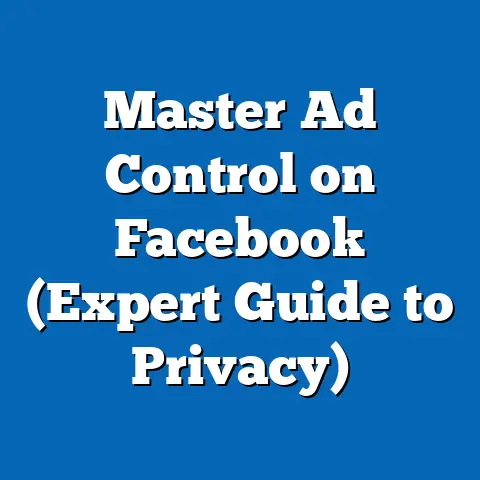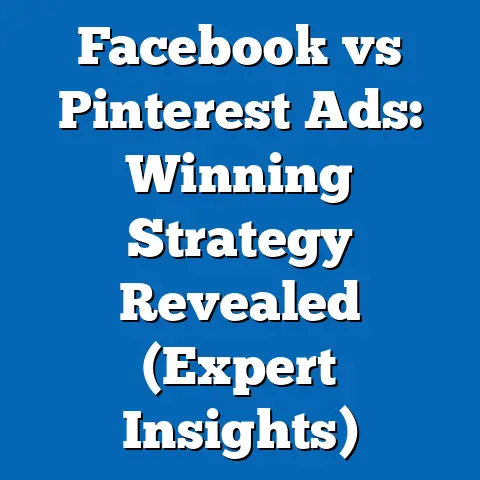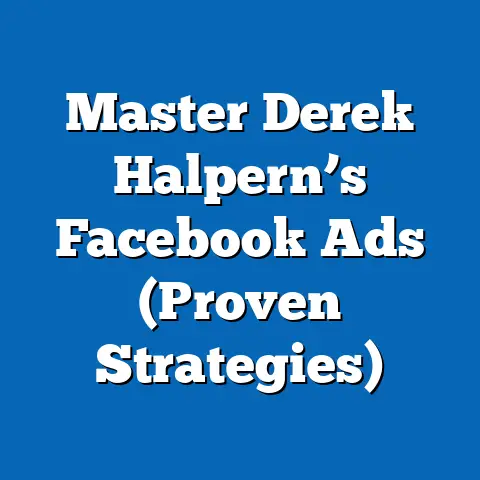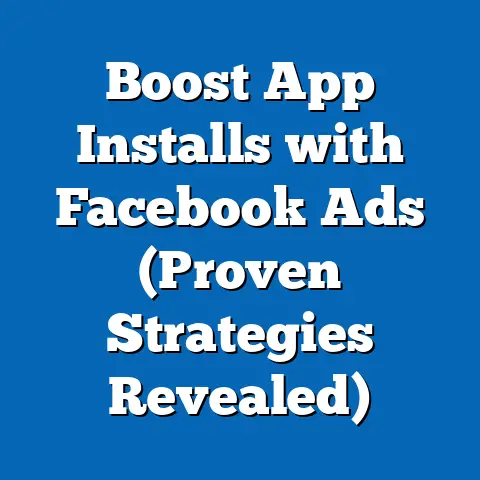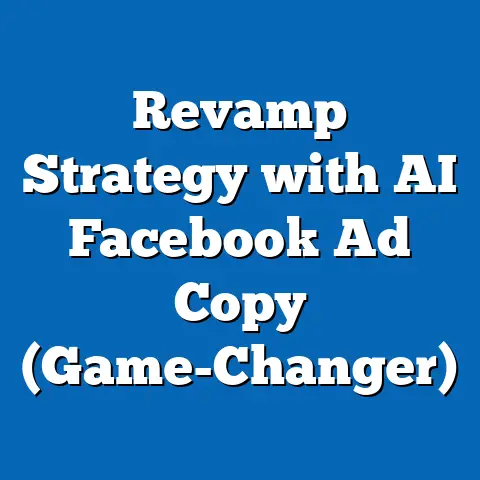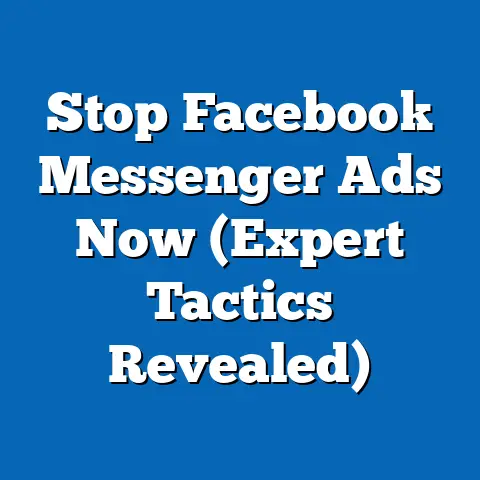Transform Facebook Ad Formats for Maximum Impact (Pro Tips)
I always tell people that Facebook advertising is like running an art gallery. Think about it: a gallery doesn’t just throw artwork on the walls and hope for the best. They carefully curate each piece, considering its placement, lighting, and how it contributes to the overall narrative. Similarly, your Facebook ads need a strategic touch to capture attention in the bustling newsfeed and tell a compelling story. It’s not just about having a great product or service; it’s about presenting it in a way that resonates with your audience. In this guide, I’m going to show you how to transform your Facebook ad formats to not only capture attention but also drive meaningful results.
Understanding Facebook Ad Formats
Before we dive into the “how,” let’s quickly recap the “what.” Facebook offers a diverse range of ad formats, each designed to cater to specific marketing objectives. I’ve spent years experimenting with these formats, and I can tell you that understanding their nuances is crucial.
- Image Ads: These are the simplest, featuring a single image or graphic with accompanying text. They are great for quick announcements or showcasing a product.
- Video Ads: Captivating and dynamic, video ads allow you to tell a story, demonstrate a product, or share a testimonial. They tend to have higher engagement rates than image ads.
- Carousel Ads: These let you display multiple images or videos in a single ad, allowing users to swipe through them. They are perfect for showcasing a range of products or highlighting different features of a single product.
- Slideshow Ads: A cost-effective alternative to video ads, slideshow ads combine a series of images with music or text to create a visually appealing experience.
- Collection Ads: Primarily for e-commerce, collection ads display a catalog of products, allowing users to browse and purchase directly from the ad.
Each of these formats has unique advantages, and the right choice depends heavily on what you’re trying to achieve. I remember working with a local bakery that wanted to promote their new line of pastries. We started with a simple image ad, but the results were lackluster. When we switched to a carousel ad showcasing each pastry with a mouthwatering photo and a brief description, engagement skyrocketed, leading to a significant increase in orders.
Takeaway: Familiarize yourself with each ad format and its strengths.
The Importance of Tailoring Your Ad Format
Why does format choice matter so much? Because it directly impacts how your message is received and acted upon. Think of it like choosing the right outfit for an occasion – a tuxedo at a beach party would be wildly out of place!
According to a recent study by HubSpot, video ads generate 1200% more shares than text and image content combined. That’s a staggering difference! But it’s not just about using the “best” format; it’s about using the right format for your specific audience and goals.
For instance, if you’re targeting a younger audience with a short attention span, a quick, engaging video ad might be more effective than a lengthy blog post. On the other hand, if you’re trying to educate prospects about a complex product or service, a carousel ad with detailed descriptions might be the better choice.
I’ve seen countless campaigns fail simply because the wrong format was chosen. I once consulted with a tech startup that was running image ads to promote their complex software solution. They were frustrated with the low conversion rates. After analyzing their target audience and the nature of their product, I recommended switching to a demo video ad. The results were dramatic – conversion rates increased by over 300% within a month!
Takeaway: Don’t just pick a format randomly. Consider your audience, your message, and your goals.
Transforming Image Ads
Image ads might seem simple, but they can be incredibly powerful when done right. I like to think of them as the “little black dress” of Facebook ads – classic, versatile, and always in style. However, just like a little black dress needs the right accessories, image ads need some thoughtful enhancements to truly shine.
- High-Quality Visuals: This is non-negotiable. Your image must be crisp, clear, and visually appealing. Avoid blurry or pixelated images at all costs. Use professional photography or high-quality stock photos.
- Compelling Imagery: Choose images that tell a story, evoke emotion, or showcase your product in an attractive way. Avoid generic or cliché images that blend into the background.
- Effective Text Overlays: Use text sparingly and strategically. A headline or short tagline can help grab attention, but avoid cluttering the image with too much text. Facebook actually penalizes ads with excessive text in the image.
- Cohesive Branding: Ensure your image ad aligns with your brand’s visual identity. Use consistent colors, fonts, and logos to create a recognizable and memorable look.
I once worked with a fashion retailer that was struggling to stand out in a crowded market. Their image ads were bland and uninspired. We completely revamped their visual strategy, focusing on high-fashion photography, bold colors, and minimalist text overlays. The result was a series of visually stunning image ads that captured the attention of their target audience and drove a significant increase in sales.
Takeaway: Elevate your image ads with high-quality visuals, compelling imagery, strategic text overlays, and cohesive branding.
Maximizing Video Ads
Video ads are the rockstars of Facebook advertising. They have the power to captivate, entertain, and persuade like no other format. But just like any rockstar, they need to put on a good show to keep the audience engaged.
- Engaging Intros: You have about 3 seconds to grab attention. Start with a hook that immediately piques interest, whether it’s a question, a surprising statistic, or a visually stunning scene.
- Subtitles and Captions: Many users watch videos without sound, so subtitles and captions are essential. They ensure your message is understood regardless of the audio setting.
- Strong Call-to-Action: Tell viewers what you want them to do next. Whether it’s visiting your website, signing up for a newsletter, or making a purchase, make your CTA clear and compelling.
I remember creating a video ad for a local gym that was struggling to attract new members. We focused on showcasing real people achieving their fitness goals through short, inspiring clips. We added upbeat music, motivational captions, and a clear call to action: “Join Now and Get Your First Month Free!” The ad went viral, and the gym saw a surge in new memberships.
Takeaway: Make your video ads engaging from the first second, accessible with subtitles, and actionable with a clear call to action.
Leveraging Carousel Ads
Carousel ads are like mini-websites within Facebook. They allow you to showcase multiple products, highlight different features, or tell a story through a series of images or videos. I’ve found them to be incredibly effective for e-commerce businesses and anyone with a diverse product range.
- Narrative Flow: Sequence your images or videos to create a compelling narrative. Start with an attention-grabbing introduction and lead viewers through a logical progression.
- Effective Card Utilization: Each card should have a strong visual and concise copy. Use each card to highlight a specific product, feature, or benefit.
- Strategic Testing: Experiment with different combinations of images, videos, and copy to optimize ad performance. A/B testing can help you identify which sequences resonate best with your audience.
I once helped an online bookstore create a carousel ad showcasing their best-selling novels. We sequenced the cards to create a sense of anticipation, starting with a mysterious cover image and gradually revealing the title and author. Each card included a brief synopsis and a link to purchase the book. The ad generated a significant increase in book sales and helped the bookstore attract new customers.
Takeaway: Tell a compelling story, utilize each card effectively, and continuously test different combinations to optimize your carousel ads.
Innovative Use of Slideshow Ads
Slideshow ads are the unsung heroes of Facebook advertising. They are a cost-effective alternative to video ads, particularly for businesses with limited resources. I’ve seen them work wonders when creativity and strategy are combined.
- Right Images and Transitions: Choose images that are visually appealing and relevant to your message. Use transitions to create a dynamic and engaging slideshow.
- Music Enhancement: Add music to enhance the viewing experience. Choose a track that complements your visuals and reinforces your brand’s personality.
- Successful Campaign Examples: Look for inspiration from successful slideshow campaigns in your industry. Analyze what made them effective and adapt those strategies to your own ads.
I helped a local travel agency create a slideshow ad showcasing their vacation packages. We used stunning images of exotic destinations, combined with upbeat music and enticing text overlays. The ad generated a significant increase in inquiries and bookings, proving that slideshow ads can be just as effective as video ads when done right.
Takeaway: Use compelling images, dynamic transitions, and complementary music to create engaging slideshow ads that rival video ads in effectiveness.
The Power of Collection Ads
Collection ads are the ultimate tool for e-commerce businesses. They allow you to showcase your product catalog in a visually appealing and interactive way, making it easy for users to browse and purchase directly from the ad. I’ve seen them dramatically increase sales for online retailers.
- Visually Appealing Collection: Curate a collection that is visually appealing and relevant to your target audience. Use high-quality product images and a cohesive design to create a seamless browsing experience.
- Seamless Shopping Experience: Ensure a smooth transition from the ad to the product page. Make it easy for users to add products to their cart and complete their purchase.
- Brand Success Examples: Study brands that have successfully utilized collection ads to drive sales. Analyze their strategies and adapt them to your own business.
I worked with an online clothing retailer that was struggling to convert ad clicks into sales. We implemented collection ads, showcasing their latest arrivals in a visually stunning format. We streamlined the checkout process, making it easy for users to purchase directly from the ad. The result was a significant increase in sales and a higher return on ad spend.
Takeaway: Curate a visually appealing collection, ensure a seamless shopping experience, and learn from successful brands to maximize the power of collection ads.
A/B Testing and Analytics
No matter how creative or strategic you are, you can’t know for sure what will resonate with your audience until you test it. A/B testing and analytics are essential for optimizing your Facebook ad formats and maximizing your results. I always tell my clients, “Don’t guess, test!”
- A/B Testing Methods: Experiment with different ad formats, images, videos, copy, and calls to action. A/B testing allows you to identify which variations perform best.
- Key Metrics Tracking: Track key metrics such as click-through rate (CTR), conversion rate, and cost per acquisition (CPA). These metrics will help you assess the effectiveness of your ads.
- Strategic Adjustments: Based on your performance data, adjust your strategies accordingly. Continuously refine your ads to improve their effectiveness.
I once helped a software company optimize their Facebook ad campaigns through rigorous A/B testing. We tested different ad formats, headlines, and calls to action. We tracked key metrics such as CTR and conversion rate. Based on our findings, we made strategic adjustments to our ads, resulting in a significant increase in leads and sales.
Takeaway: Continuously test different variations, track key metrics, and adjust your strategies based on performance data to optimize your Facebook ad formats.
Conclusion
Just like an art gallery carefully curates its exhibits, you need to thoughtfully craft your Facebook ads to capture the attention of your audience and convey your message effectively. By understanding the unique strengths of each ad format and applying the pro tips shared in this guide, you can transform your Facebook advertising efforts and achieve maximum impact. Remember, it’s not just about what you say, but how you say it. So, experiment with different formats, test your assumptions, and continuously refine your strategies to create Facebook ads that truly resonate with your audience and drive meaningful results.
Call to Action
Now it’s your turn. Share your experiences with Facebook ad formats in the comments section below. What has worked for you? What challenges have you faced? I’m eager to learn from your insights and continue the conversation. And be sure to follow my page for more tips, strategies, and updates on effective Facebook advertising. Let’s transform the world of Facebook advertising, one ad format at a time!

